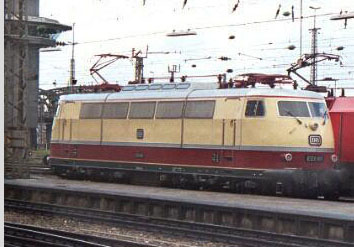| |
Epoch III
Introduction
A new start
The first trains after the war
The first network of long-distance trains
Moving forward, more trains, more comfort, more regularity
Pre war rolling stock again in service
The start of an international long-distance network
The blue network of fast express trains
The modern era, the rise of electric locomotives
The modern diesel locomotive is coming
A new class of coaches
The third class is abandoned
The last new steam engine
A new prestious network, the Trans Europ Express
The Rheingold, from 1962 again exclusive
A new star on rails, the electric locomotive E 03
A new star on rails, the electric locomotive E 03
In the sixties the DB wanted to offer 200 km/h express train services. For these high graded express train services they needed a fast locomotive. In the beginning of the project they thought of a locomotive which was derived of the E 18/E 19 locomotives, but soon the engineers abandoned this idea. Then they decided to develop a locomotive on the basis of the E 10 locomotives. In March 1961, the DB commissioned the German locomotive industry to develop a prototype of a locomotive with a power of 5000 kW and a maximum speed of 200 km/h. The first designs of Henschel were of a six axle locomotive (Co'Co'). The consortium Krupp/AEG designed a locomotive with an axle layout of (1Bo)(Bo1) and a locomotive with an axle layout of (1A1)(1A1), both with non powered axles. Later the DB choosed for a locomotives with six powered axles with an axle layout of (Co'Co').
 | | The E 03 001 in München Hbf | Photo: Michael Taylor (http://www.michaeltaylor.ca) |
They decided to built the locomotives by a consortium of Henschel and Siemens. At the beginning of the developments of this new locomotive they enrolled an extensive testing program with the locomotives E 10 299 and E 10 300. These two class E 10 locomotives were equiped with bogies capable of running at speeds of 200 km/h, they had also changed gears, different panthographs, different axle bearings and a series of other modifications. On the route between Bamberg and Forchheim, the DB made testruns with these two E 10 locomotives. The test results were very positive and so the DB decided to develop the new high speed locomotive class E 03.
In 1965, four prototype locomotives were delivered by Henschel and Siemens. Henschel had built the body parts and Siemens was responsible for the electrical parts of the locomotives. The new six axle locomotives were entering service as E 03 001 through E 03 004. In comparison with the serie locomotives class BR 103.1, the E 03 locomotives had only one row of ventilation grids on both sides of the locomotive body.
The E 03 001 was exhibited in 1965 on the international traffic exhibition in München. The other three locomotives were in service in special trains between München and Augsburg, these trains ran at speeds of 200 km/h.
After an extensive testprogram it was time to put the locomotives in the regular services. With the summer timetable of 1966, the locomotives had a service of three days. Among the trains they pulled were the TEE 55/56 "Blauer Enzian" between München and Hamburg.
The locomotives appeared to function very well in the regular services and the results were very positive. The locomotives got on 1 January 1968 their new numbers and were indicated as class BR 103.0. As the result of the positive tests achieved with the extensive test program, the Deutsche Bundesbahn decided in 1969 to order the serie locomotives of class BR 103.1.
|
